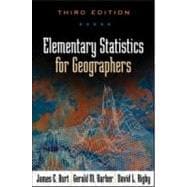Widely adopted, this uniquely comprehensive text introduces the techniques and concepts of statistics in human and physical geography. Unlike other texts that gloss over the conceptual foundations and focus solely on method, the book explains not only how to apply quantitative tools but also why and how they work. Students gain important skills for utilizing both conventional and spatial statistics in their own research, as well as for critically evaluating the work of others. Most chapters are self-contained in order to provide maximum flexibility in course design. Requiring no math beyond algebra, the book is well suited for undergraduate and beginning graduate-level courses. Helpful features include chapter summaries, suggestions for further reading, and practice problems at the end of each chapter.
New to This Edition
*Restructured and updated to reflect current developments in the field.
*Five entirely new chapters cover graphical methods, spatial relationships, analysis of variance, extending regression analysis, and spatial analysis.
*Features even more worked examples, many with accompanying graphics.
*The companion website offers datasets and solutions to selected end-of-chapter exercises.








